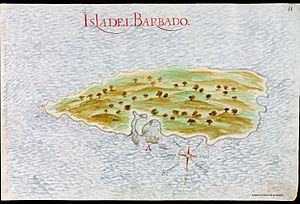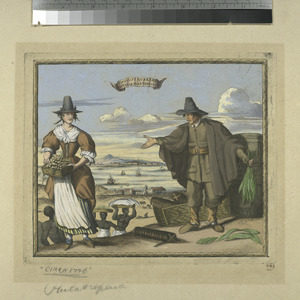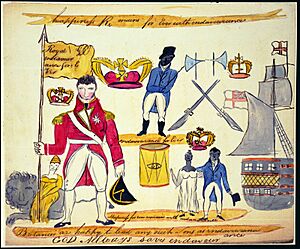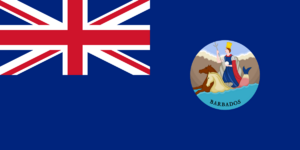History of Barbados facts for kids
Barbados is an island country in the southeastern Caribbean Sea. It's about 100 km (62 mi) east of Saint Vincent and the Grenadines. The island is shaped like a triangle, measuring about 21 km (13 mi) from northwest to southeast and 14 km (8.7 mi) from east to west at its widest point. The capital and largest town is Bridgetown, which is also a major seaport.
Before Europeans arrived in the 1500s, Barbados was home to native peoples like the Arawaks and Caribs. The Spanish Empire briefly claimed the island, naming it Barbados because of trees that looked like they had beards. Then, Portugal claimed it from 1532 to 1620. From 1625 until 1966, Barbados was an English and later a British colony.
Growing sugar cane started in the 1640s, which led to many enslaved people being brought from West Africa. Laws called "slave codes" were put in place in the late 1600s, leading to several attempts at rebellion, but none succeeded. After the biggest slave rebellion in Barbadian history, known as Bussa's Rebellion, the Consolidated Slave Law was passed. Slavery was completely abolished in the British Empire in 1834. Britain continued to rule Barbados until it gained independence in 1966. After that, it became a member of the Commonwealth of Nations.
From 1966 to 2021, Barbados was a constitutional monarchy and a parliamentary democracy, similar to the British system. Elizabeth II, the Queen of Barbados, was the head of state. However, on November 30, 2021, Barbados became a republic under Mia Mottley, meaning the Queen was no longer its head of state.
Contents
Early History of Barbados
Some clues suggest that people might have lived in Barbados as early as 2000 BC. However, clear evidence of Amerindian settlements dates from about 350 to 650 AD, when the Troumassoid people arrived from South America.
Another group, called "Arawaks" by the Spanish, came around 800 AD. A third group arrived in the mid-1200s. Surprisingly, these native settlements ended in the early 1500s. There is no proof that the Kalinago (also called "Caribs") ever lived permanently in Barbados, though they often visited in their canoes.
Colonial Times
First European Arrivals
The Portuguese were the first Europeans to find the island. A Portuguese sailor named Pedro A. Campos called it Os Barbados, which means "the bearded ones."
In the early 1500s, the Spanish Empire often raided the island for enslaved people. This caused the native population to drop greatly. By 1541, a Spanish writer even said the island was empty. The native people were either captured by the Spanish or ran away to nearby islands that were easier to defend.
Around 1600, the English, French, and Dutch started setting up colonies in North America and the smaller islands of the West Indies. Although Spanish and Portuguese sailors had visited Barbados, the first English ship landed there on May 14, 1625. England was the first European country to create a lasting settlement in 1627. The ship William and John arrived with over 60 white settlers and six enslaved Africans.
England officially claimed Barbados in 1625 for King James I. Other English settlements had already been made in the Americas, like Jamestown (1607) and Plymouth Colony (1620). However, the Colony of Barbados quickly became the third most important English settlement in the Americas because of its good location in the east.
Early English Settlements
The first settlement was set up as a private colony. It was funded by Sir William Courten, a London merchant who owned the rights to Barbados and other islands. So, the first colonists were like tenants, and much of their earnings went back to Courten and his company.
The first English ship, led by Captain John Powell, arrived on May 14, 1625. The actual settlement began on February 17, 1627, near what is now Holetown. It was led by John Powell's younger brother, Henry, and included 80 settlers and 10 English laborers. These laborers were young indentured laborers, some of whom had been taken against their will. About 40 enslaved Taino people were brought from Guyana to help grow crops on the island's west coast.
Courten's ownership was later given to James Hay, 1st Earl of Carlisle, in an event called the "Great Barbados Robbery." Carlisle started his own settlement at what he called Carlisle Bay, which later became Bridgetown.
Carlisle then chose Henry Hawley as governor. In 1639, Hawley created the House of Assembly to keep the planters happy, as they might have opposed his appointment otherwise. By that year, 12 years after the settlement began, there were an estimated 8,700 white adults living there.
Between 1640 and 1660, the West Indies attracted over two-thirds of all English people who moved to the Americas. By 1650, there were 44,000 settlers in the West Indies, compared to 12,000 in the Chesapeake area and 23,000 in New England.
Most English arrivals were indentured servants. After five years of work, they received "freedom dues" worth about £10, usually in goods. Before the mid-1630s, they also received 5–10 acres of land. However, after that, the island became full, and there was no more free land. Around the time of Oliver Cromwell, some rebels and criminals were also sent to Barbados.
At first, the colony's economy relied on growing and exporting tobacco. But tobacco prices dropped in the 1630s as more was grown in the Chesapeake region.
Sugar Cane and Slavery

Growing sugar cane in Barbados began in the 1640s, after Pieter Blower brought it to the island in 1637. At first, rum was made, but by 1642, sugar became the main focus. As sugar became the most important business, Barbados was divided into large plantation estates. These replaced the smaller farms of the early English settlers, as wealthy planters bought out the poorer ones. Some of these displaced farmers moved to English colonies in North America, especially South Carolina.
To work the plantations, enslaved black Africans, mostly from West Africa, were brought in. There were so many that there were three enslaved people for every one planter. After 1750, many plantations were owned by people living in Britain who hired managers to run them. Enslaved people had a short life expectancy, and new ones were bought every year.
The arrival of sugar cane from Dutch Brazil in 1640 completely changed society and the economy. Barbados eventually had one of the world's largest sugar industries. A group of Sephardi Jews, who had been forced to leave the Iberian peninsula and then Dutch Brazil, helped make the industry successful. As sugar growing increased, the mix of people in Barbados and nearby islands also changed. A working sugar plantation needed a lot of money and a lot of hard work. At first, Dutch traders provided the tools, money, and enslaved Africans, and they also transported most of the sugar to Europe. Barbados took over from Hispaniola as the main sugar producer in the Caribbean.
In 1655, Barbados had about 43,000 people. About 20,000 were of African descent, and most of the rest were of English descent. These English small farmers were eventually bought out, and the island became filled with large sugar plantations worked by enslaved Africans. By 1660, there were almost equal numbers: 27,000 black people and 26,000 white people. By 1666, at least 12,000 white small farmers had been bought out, died, or left the island. Many of the remaining white people became poorer. By 1673, enslaved black people (33,184) outnumbered white settlers (21,309). By 1684, the difference grew even more, with 19,568 white settlers and 46,502 enslaved black people. By 1696, there were an estimated 42,000 enslaved black people, and the white population dropped further to 16,888 by 1715.
Because of the strict slave codes, which treated Africans differently from white workers and the ruling planter class, Barbados became less appealing to poor white people. Slave codes were put in place in 1661, 1676, 1682, and 1688. In response, several slave rebellions were attempted or planned, but none succeeded. Still, poor white people who could leave often did. Planters brought in more enslaved Africans to grow sugar cane.
By 1660, Barbados created more trade than all other English colonies combined. This continued until larger islands like Jamaica surpassed it in 1713. But even so, the estimated value of the Colony of Barbados in 1730–1731 was as much as £5,500,000. Bridgetown, the capital, was one of the three largest cities in English America. By 1700, the English West Indies produced 25,000 tons of sugar. This quickly replaced tobacco as the island's main export.
So much land was used for sugar that most food had to be brought in from New England. The poorer white people who left the island went to the English Leeward Islands, or especially to Jamaica. In 1670, the Province of South Carolina was founded, and some people from Barbados moved there. Other places that received many Barbadians included British Guiana and Panama.
Enslaved people did not just work in sugar cane fields. They also raised animals, fertilized soil, grew food crops, maintained plantation buildings, and cared for others. One clever farming method was intercropping, where food crops were planted between rows of sugar cane. This required enslaved people to be skilled and observant to use the land efficiently.
By 1750, there were about 18,000 white settlers, compared to about 65,000 enslaved Africans. The slave trade ended in 1807, and enslaved people were freed in 1834.
Bussa's Rebellion


The British stopped the slave trade in 1807, but they did not end slavery itself. Slavery was finally abolished in most parts of the British Empire in 1833.
In 1816, enslaved people in Barbados started an uprising known as Bussa's rebellion. This was the largest slave uprising in the island's history. About 20,000 enslaved people from over 70 plantations were involved. The rebellion was partly sparked by news about the growing movement to end slavery in England, and the local white people's opposition to it.
The rebellion surprised many planters. They thought their enslaved people were happy because they were allowed weekly dances, took part in social and economic activities, and were generally fed and cared for. However, the planters had refused to change the Barbados Slave Code since it began. This code denied enslaved people basic human rights. This led to "Bussa's Rebellion," named after the slave ranger Bussa. The rebels felt that the treatment of enslaved people in Barbados was "intolerable." They believed the political situation in Britain made it a good time to try to peacefully negotiate for freedom. Bussa became the most famous organizer of the rebellion. Many organizers were enslaved people in higher positions or literate freedmen. A woman named Nanny Grigg is also named as a main organizer.
However, the rebellion failed. It started too early, and the enslaved people were greatly outnumbered. Barbados' flat land gave the better-armed militia's horses a clear advantage over the rebels, as there were no mountains or forests to hide in. The enslaved people had also thought they would be supported by freed people of color, but these individuals instead helped to stop the rebellion. Although the rebels drove white people off the plantations, there were no widespread killings. In the end, 120 enslaved people died in fighting or were immediately executed. Another 144 were put on trial and executed. The remaining rebels were sent off the island.
Towards the End of Slavery
In 1826, the Barbados government passed the Consolidated Slave Law. This law gave some small rights to enslaved people while also reassuring slave owners.
Slavery was finally abolished in the British Empire eight years later, in 1834. In Barbados and other British West Indian colonies, full freedom from slavery was followed by a difficult four-year period of apprenticeship.
Towards Independence
Plantation owners and merchants of British descent still controlled local politics. This was because only people with high incomes could vote. More than 70 percent of the population, including many women, could not vote. It wasn't until the 1930s that the descendants of freed enslaved people began a movement for political rights. One of the leaders, Sir Grantley Adams, started the Barbados Progressive League in 1938. This group later became the Barbados Labour Party (BLP).
Adams and his party demanded more rights for poor people. They strongly supported the monarchy. Progress towards a more democratic government in Barbados was made in 1942. The income requirement for voting was lowered, and women were given the right to vote. By 1949, the planters lost control of the government, and in 1953, Adams became Premier of Barbados.
From 1958 to 1962, Barbados was one of the ten members of the West Indies Federation. This was a group of islands trying to unite, but it failed due to nationalistic feelings. Grantley Adams was its first and only "Premier." However, his leadership failed to form other unions, and his continued support for the monarchy made his opponents say he was out of touch with his country's needs. Errol Walton Barrow, a strong reformer, became the new leader for the people. Barrow had left the BLP and formed the Democratic Labour Party (DLP) as a more liberal choice to Adams' conservative government. Barrow started many helpful social programs, such as free education for all Barbadians and a school meals system. By 1961, Barrow had replaced Adams as Premier, and the DLP controlled the government.
When the Federation broke up, Barbados went back to being a self-governing colony. The island negotiated its own independence with Britain in June 1966. After years of peaceful and democratic progress, Barbados finally became an independent state on November 30, 1966. Errol Barrow became its first prime minister, with Elizabeth II as Queen of Barbados. After independence, Barbados became a full member of the Commonwealth of Nations. A year later, Barbados joined both the United Nations and the Organization of American States.
Independence
With Errol Barrow leading the way, Barbados successfully negotiated its independence with the United Kingdom in June 1966. After years of peaceful and democratic progress, Barbados finally became an independent state and officially joined the Commonwealth of Nations on November 30, 1966. Errol Barrow served as its first prime minister.
The Barrow government worked to make the economy less dependent on agriculture. They aimed to boost industry and tourism. Barbados also played a leading role in efforts to unite the region, helping to create CARIFTA and CARICOM. The DLP lost the 1976 Barbadian general election to the BLP, led by Tom Adams. Adams took a more conservative and pro-Western approach. He allowed the Americans to use Barbados as a base for their invasion of Grenada in 1983. Adams died in office in 1985 and was replaced by Harold Bernard St. John. However, St. John lost the 1986 Barbadian general election, which brought the DLP back to power under Errol Barrow. Barrow had been very critical of the US involvement in Grenada. Barrow also died in office and was replaced by Lloyd Erskine Sandiford, who remained prime minister until 1994.
Owen Arthur of the BLP won the 1994 Barbadian general election and stayed prime minister until 2008. Arthur strongly supported Barbados becoming a republic, but a planned vote to replace Queen Elizabeth as Head of State in 2008 never happened. The DLP won the 2008 Barbadian general election, but the new Prime Minister David Thompson died in 2010 and was replaced by Freundel Stuart. The BLP returned to power in 2018 under Mia Mottley, who became Barbados's first female prime minister.
Becoming a Republic
On September 15, 2020, the Government of Barbados announced its plan to become a republic by November 30, 2021. This date marked the 55th anniversary of its independence. This change meant replacing the Queen of Barbados with an elected president. Barbados would then no longer be a Commonwealth realm, but it could still be a member of the Commonwealth of Nations, like Guyana and Trinidad and Tobago.
On September 20, 2021, the Constitution (Amendment) (No. 2) Bill, 2021, was introduced to the Parliament of Barbados. It passed on October 6. This Bill changed the Constitution of Barbados, creating the office of the President of Barbados to replace the role of Elizabeth II, Queen of Barbados. The next week, on October 12, 2021, the current Governor-General of Barbados Sandra Mason was chosen by both the Prime Minister and the Leader of the Opposition to be the first President of Barbados. She was then elected on October 20. Mason took office on November 30, 2021. Prince Charles, who was next in line to the Barbadian Crown, attended the ceremony in Bridgetown because the Government of Barbados invited him.
Queen Elizabeth II sent a message to President Mason and the people of Barbados. She said: "As you celebrate this momentous day, I send you and all Barbadians my warmest good wishes for your happiness, peace and prosperity in the future."
A survey taken between October 23 and November 10, 2021, by the University of the West Indies showed that 34% of people supported becoming a republic, while 30% were unsure. No clear majority was found in the survey. 24% did not say what they preferred, and the remaining 12% were against removing Queen Elizabeth.
In January 2022, Barbados Prime Minister Mia Mottley's Labor Party won a huge victory. They won all 30 legislative seats in the first general election since Barbados became a republic.
On June 20, 2022, a Constitutional Review Commission was formed to review the Constitution of Barbados. The Commission has 18 months to finish its work. They are expected to ask for ideas from the public in Barbados through meetings and online events.
Past Union Ideas
In the past, there have been ideas to join Barbados with neighboring countries or even with Canada. So far, all these plans have failed. One idea in 1876 even led to deadly riots. This happened when Governor John Pope Hennessy tried to force Barbadian politicians to join more closely with the Windward Islands. Governor Hennessy was quickly moved from Barbados by the British Crown. In 1884, the Barbados Agricultural Society tried to get Barbados to form a political group with Canada. From 1958 to 1962, Barbados was one of the ten states in the West Indies Federation. Lastly, in the 1990s, the leaders of Guyana, Barbados, and Trinidad and Tobago planned to form a political group. This deal was also never finished after Sir Lloyd Erskine Sandiford lost the Barbadian general elections.
Images for kids
See also
 In Spanish: Historia de Barbados para niños
In Spanish: Historia de Barbados para niños
- Military history of Barbados
- British colonization of the Americas
- French colonization of the Americas
- History of the Americas
- History of North America
- History of the British West Indies
- List of prime ministers of Barbados
- List of governors of Barbados
- Longitude
- Piracy in the Caribbean
- Politics of Barbados
- Spanish colonization of the Americas
- Timeline of Barbadian history
- West Indies Federation






